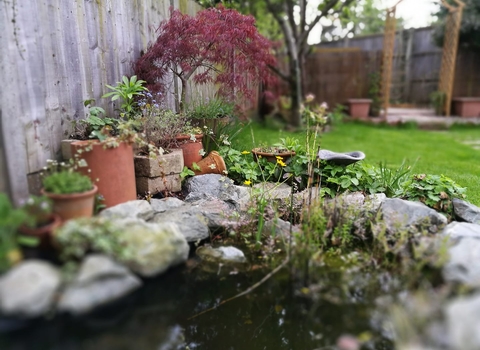Is it OK to use tap water to fill up my pond?
Your pond will be happiest with rainwater as tap water has additional nutrients which can allow weeds to flourish and upset the natural balance of your new ecosystem. However, ponds can be topped up in dry weather with tap water if necessary (remember some evaporation is normal and to be expected). If you only have tap water to use for your pond, leave it in a bucket at room temperature for 24 hours before adding it to your pond to allow the chlorine to dissipate.
How deep does my pond need to be?
A pond with some depth of 60cm will be perfect for breeding frogs, but a variety of depths with some shallow areas will provide the richest habitat for a range of pond wildlife. A mini pond of between 20cm and 30cm-deep will still be of great value to wildlife in your garden.
Can I have fish in my wildlife pond?
While fish can be attractive additions to a pond, they prey on smaller wildlife and increase water nutrient levels with their waste, having a detrimental effect on the diversity in a pond. If you want a wildlife pond, it is best to leave out the ornamental fish.
How much maintenance will my pond need?
In general, your pond shouldn’t need too much maintenance, but here are a few things you could schedule in throughout the year:
- Some fallen leaves and debris can be good hiding places for small creatures, but excess fallen leaves should be removed in autumn.
- If your plants are growing rapidly and swamping the water, they can be cut back in summer. Resist the urge to pass on cuttings to friends or family due to the risk of spreading disease or unwanted invasive species.
- Weeds such as blanketweed can suffocate the pond and reduce its oxygen levels, so take precautions by adding barley straw products in spring to discourage its build up. If you need to pull out excess, making sure to check for any attached wildlife. The blanketweed can be swilled in a bucket of pond water after being removed, adding the water and any creatures back into the pond.
- Don’t worry too much about your pond freezing over, as algae and pond plants continue to produce oxygen even in winter. If your pond or water feature is the only drinking source for wildlife in your garden though, you could leave a small ball on the surface overnight, removing it in the morning to allow access to the water. Alternatively, hold a hot saucepan over the surface until it melts a hole.
- In summer if you are worried that your mini pond is overheating, move it further into the shade, or stand some container plants around the edges to create some shade.
What is the best type of pond container to use?
The main thing is that your container is water-tight and can be made wildlife friendly with sloping sides either with ledges, or stones or log piles to allow wildlife in and out. Apart from this, you can use anything as long as it is a minimum 20-30cm deep and around 30cm wide – if it has had a former life, all the better! Non water-tight pots can be lined with pond liner.
Can I get my pond started more quickly by taking some water, plants or frogspawn from another pond?
This used to be accepted wisdom, but we now know that moving wildlife, water or plants from one pond to another can spread disease and invasive species. Resist the urge to leap-frog ahead by sharing water, plants or wildlife with your friends and family, but do compare your progress and observations and learn from each other as you go!
How many pond plants do I need?
Aim for around one plant per square metre and a mixture of oxygenators, floating plants and marginal plants for the edges of your pond.
Seek out quality plant centres and opt for UK-native species where possible. Download a free pond booklet for a list of possible plants, or visit the RHS website.
What should I do if I see a frog or toad in my garden and I don’t have a pond?
It is probably searching for a mate, hopping between ponds or simply going about its daily business. Amphibians only need water to breed so don’t try to move it or put it in water. This does mean there is appetite in your patch for a pond though, so why not get started?
What should I do if I see a frog or toad on the road?
Toads can move more slowly and sometimes need a helping hand crossing a road as they search for a mate or breeding site. They can be picked up with rubber gloves and added to a bucket with damp vegetation or a wet small towel before being moved to the closest pond (in the direction they were travelling in). Frogs are quicker across roads so should safely manage, and they are tricky to catch, but can also be moved to the nearest pond.
Volunteers with Ham and Petersham in Bloom stay ‘on duty’ during spring evenings with road blocks and signs, to help frogs and toads cross to the three ponds they created for them!
Ham and Petersham’s toad patrol
More questions?
Get more tips from the downloadable pond booklet or visit wildlifetrusts.org/gardening for more gardening info.

